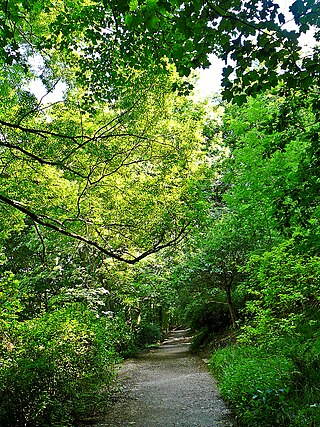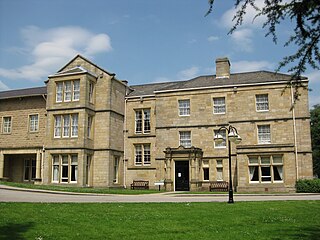
Moortown is an affluent suburb of Leeds, West Yorkshire, England in the LS17 and LS8 postcode districts. It is a civil parish and sits in the Moortown ward of Leeds City Council in the north east of the city.

Chapeltown is a suburb of north-east Leeds, in West Yorkshire, England. It is part of the Leeds City Council Ward of Chapel Allerton. It is approximately one mile north of Leeds city centre.

Scott Hall is a suburb of north-east Leeds, West Yorkshire, England, adjacent to Chapeltown and Meanwood. The suburb falls within the Chapel Allerton and Moortown wards of Leeds City Council. The Scott Hall estate is made up largely of 1930s council housing on both sides of Scott Hall Road from Buslingthorpe Lane in the south to Potternewton Lane in the north.

Meanwood is a suburb and former village in north-west Leeds, West Yorkshire, England.

The Meanwood Beck is a stream in West Yorkshire, England, which flows southwards through Adel, Meanwood and Sheepscar into the River Aire in central Leeds. Different portions of the same watercourse have been referred to as Adel Beck, Carr Beck, Lady Beck, Mabgate Beck, Sheepscar Beck, Timble Beck or Wortley Beck. The Meanwood Valley Trail footpath follows the line of the beck for much of its course.

Potternewton is a suburb and parish between Chapeltown and Chapel Allerton in north-east Leeds, West Yorkshire, England. It is in the Chapel Allerton ward of Leeds City Council.

This is a list of halls of residence both on and off campus at the University of Leeds in Leeds, England.

Buslingthorpe is an area of Leeds, West Yorkshire, England. It is about one mile north of the city centre and currently falls within the Hyde Park and Woodhouse ward of the City of Leeds Council. Much of the housing in the area was demolished by slum clearance in the 1950s.

The architecture of Leeds, a city and metropolitan borough in West Yorkshire, England, encompasses a wide range of architectural styles and notable buildings. As with most northern industrial centres, much of Leeds' prominent architecture is of the Victorian era. However, the City of Leeds also contains buildings from as early as the Middle Ages such as Kirkstall Abbey, one of Britain's best preserved ruined Cistercian monasteries, as well as examples of 20th century industrial architecture, particularly in the districts of Hunslet and Holbeck.

Park Square is a Georgian public square in central Leeds, West Yorkshire. The square is grassed over and is a traditional Georgian park. The square is in Leeds' financial quarter and is surrounded by Georgian buildings, which are occupied as offices, many by barristers and solicitors.

All Souls' Church, Blackman Lane, in Leeds, West Yorkshire, England is a large Victorian Church of England parish church. Worship at All Souls is in the Anglo-Catholic tradition of the Church of England.

Chapel Allerton is an inner suburb of north-east Leeds, West Yorkshire, England, 2 miles (3.2 km) from the city centre.

Woodhouse Ridge is a strip of woodland on the South West hillside of the Meanwood valley in urban area of Leeds, West Yorkshire, England. Locally known as 'The Ridge', the area is notable as a significant area of mature woodland in an otherwise highly developed urban area. The woods are centred at grid reference 53.820061, -1.560144 and are enclosed by Meanwood Road to the east and by Headingley to the north and Woodhouse, Leeds to the South.

Our Lady of Lourdes Church is a Roman Catholic church in the parish of St Jeanne Jugan, Leeds. It was built by the Society of Jesus in the 1920s and it is situated on Cardigan Road in Burley, Leeds.

Robert Mawer was an architectural sculptor, based in Leeds, West Yorkshire, England. He specialised in the Gothic Revival and Neoclassical styles. He created the Neoclassical keystone heads on St George's Hall, Bradford and on Moorland's House, Leeds, and was working on the keystone heads at Leeds Town Hall when he died. He was a founding member of the Mawer Group of Leeds architectural sculptors, which included his wife, Catherine Mawer, his son Charles Mawer, and his apprentices William Ingle, Matthew Taylor and Benjamin Payler, who all became sculptors with their own careers. Many of the buildings enhanced with sculpture by Robert Mawer are now listed by Historic England.

St Augustine's Church, Wrangthorn, usually referred to as simply Wrangthorn, is the church of the parish of Woodhouse and Wrangthorn, Leeds, West Yorkshire, England. It is near Hyde Park Corner at the top of Woodhouse Moor. It shares a benefice and clergy with St George's Church in the city centre, although the parishes remain separate. It was paid for by the Leeds Church Extension Society in 1866 and completed in 1871. The church, which is a Grade II listed building is on a ridge of land between Meanwood Beck and the Aire Valley, on the north-west side of the city. Its architect, James Barlow Fraser (1835–1922), took advantage of this prominent location by including a three-stage pointed steeple; its blackened stone is a local landmark. The church is built in local gritstone ashlar in the Gothic Revival style and is adjoined by the smaller church hall of 1934.
Ann Husler (1803–1874), née Procter, was a quarry owner and stone merchant based in Weetwood, Leeds, in West Yorkshire. She ran a quarry business after the death of her husband, John Husler. She ran the business until her death at the age of 71, after which she left her share of the business to one of her sons.























